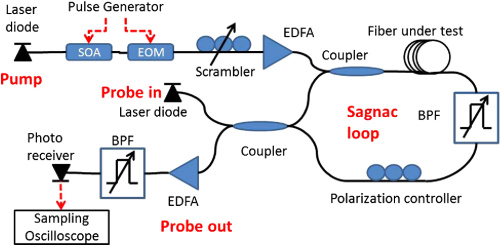Researchers Develop New Fiber-Optic Chemical Sensing Method Using Light


Researchers have created a fiber-optic based chemical sensing method that takes light within a fiber in order to produce sound waves on the outside. This provides researchers with information about what lies around the fiber. This new practice holds promise to better sensing possibilities in industrial processes and remote chemical detection, along with many other applications.
Avi Zadok, Faculty of Engineering and Institute of Nano-Technology, Bar-IIan University in Israel led a team of researchers with graduate student Yair Antman. Zadok says a key restraint that causes chemical sensing to be so troublesome is that there has to be an overlap between the light as well as the substance that is being calculated. This limitation alone has held researchers back for numerous years when it comes to fiber sensor technology.
The team demonstrated their sensing method in the Optical Society’s journal, entitled Optica. Zadok said the researchers employed the interrelations between light and sound, and use sound as their messenger to the outside world.
Optical fibers are great for sensing chemicals because of their petite size and ability to be remotely used. They are able to measure chemicals as far as tens of kilometers from their location and can be installed into the most risky environments. However, current methods require light within the fiber to come into direct contact with the substance to be measured, allowing light to leave the area.

Instead of using light directly, Antman tried using light transmitted through optical fibers in order to produce sound waves. This phenomenon known as Brillouin Scattering keeps light and sound waves from traveling outside of the fiber. Zadok called this a critical step in the research, taking advantage of mechanical behaviors that reach to the exterior of the fiber. Upon using Brillouin Scattering in a forward direction, the team was able to receive data located outside of the fiber.
This new method works by using excessive optical waves that are so strong, they reach to the surface of the fiber. The vibrations fade as they enter the substance that surrounds the fiber, allowing chemical sensing of the outer environment. Traditional optical fibers without modifications to their structure can be used because the light remains contained within the fiber.
Researchers tested their technique in ethanol and deionized water, recording liquid density measurements as well as the speed of sound waves as they made their way through the liquid. The results displayed results within a 1% precision of previously recorded data. Tests were also able to differentiate between water samples with varying levels of salinity.
These new findings may one day help monitor water desalinization, or even detect concentration changes of ions or dissolved salts during chemical processes. This could also be used in order to detect certain chemicals. The outside layer of the fiber would simply need to be treated to attract the desired chemical(s). This alone could potentially help to detect explosives or even dangerous pathogens in the not so distance future.
Zadok says there is still a lot of work to be done and research to be completed but there is promise of many applications for the new findings. The researchers found their way out of one paradox, in which you cannot simultaneously be both inside and outside of an object at the same time, and they plan on finding ways to explore a wide range of other paradoxes.









